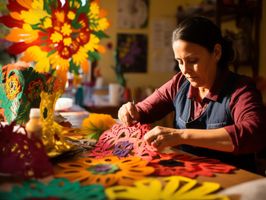The Rich Tapestry of Día de Muertos and Papel Picado
A History for Paper Enthusiasts
Growing up in California, I was surrounded by a melting pot of cultures, but one celebration that always stood out to me was Día de Muertos. The vibrant colors, the joyous gatherings, and the beautiful altars made this festival a favorite of mine. As a paper crafting enthusiast, I was particularly drawn to the intricate papel picado that adorned every corner. This festival not only connected me to my community but also sparked my lifelong admiration for this incredible tradition. Unlike the dark and spooky vibes of Halloween, Día de Muertos is a bright and life-affirming celebration that feels like a warm embrace from the past.
Día de Muertos, or Day of the Dead, is a Mexican holiday celebrated on November 1st and 2nd that’s anything but spooky. Think of it as a family reunion, but with guests from the spirit world! Families come together to honor their dearly departed with vibrant altars (ofrendas), marigold flowers (cempasúchil), sugar skulls (calaveras), and lively gatherings that are more fiesta than funeral. This celebration blends ancient Aztec rituals with Catholic traditions, creating a colorful tapestry that honors both life and death in the most joyful way possible.
The origins of Día de Muertos stretch back over 3,000 years to the Aztec, Toltec, and other Nahua peoples who saw death as just another part of the grand cycle of life. They believed that the dead were still very much part of the community, living on in memory and spirit. During Día de Muertos, it’s believed that these spirits return to the world of the living to join the festivities. It’s a time for family, for memories, and for celebration, proving that love and laughter can indeed transcend even the grave.
Papel Picado: Crafting Tradition into Art
No Día de Muertos celebration is complete without the stunning papel picado, or "perforated paper." These intricate designs fluttering in the breeze are like the holiday’s confetti—bright, beautiful, and full of life. Papel picado decorates altars and streets with its delicate patterns, making it a symbol of Mexican folk art and a central part of the celebration.
The story of papel picado begins in pre-Hispanic Mexico, where the Aztecs crafted ceremonial decorations from amate paper, made from bark. Fast forward to the 16th century, and the Spanish introduced Chinese paper to Mexico, leading artisans to create even more elaborate designs. Using tiny chisels, they carve out stacks of colorful tissue paper into beautiful patterns. Traditional designs often include skeletons, flowers, and religious symbols, each one meticulously crafted to honor the dead and add a touch of visual magic to the festivities. The colors of papel picado also carry deep meanings: purple for mourning, pink and white for hope and celebration, and yellow and orange for life and death.
The Cultural Significance
Papel picado isn’t just pretty decor—it’s a reminder of the fragility and beauty of life. As the delicate paper sways with the slightest breeze, it symbolizes the wind and the ever-present spirits of our ancestors. It’s a poignant reminder that life is fleeting, but memories and love are eternal.
While papel picado is a highlight of Día de Muertos, it also adorns various other Mexican celebrations, such as weddings, quinceañeras, and Independence Day. Its intricate beauty and cultural significance have crossed borders, making it a cherished form of art worldwide.
Día de Muertos and papel picado are more than just traditions; they’re a celebration of life, love, and memory. They offer a beautiful way to honor our ancestors and remind us of the joy and vibrancy of life. So, whether you’re creating your own papel picado or simply admiring its intricate designs, you’re participating in a rich cultural tradition that celebrates the bonds that connect us all. Unlike the spooky shadows of Halloween, Día de Muertos shines a bright light on the joy and continuity of life, making it a festival that’s both heartwarming and unforgettable.

